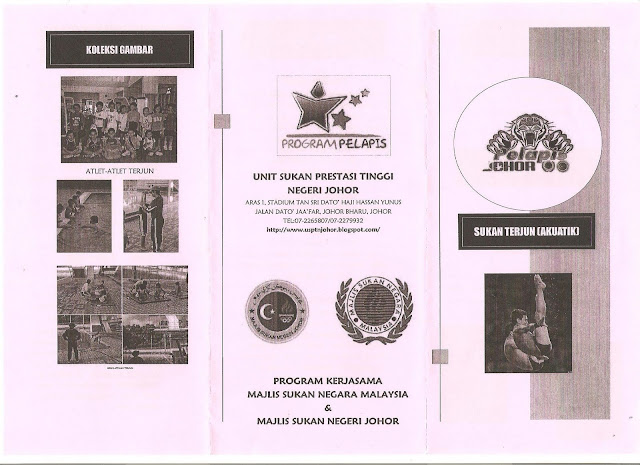Dive Numbers and The Written Description
Dives used in competition are described and entered onto a diving score sheet using two methods: a written description, or numerical identification known as a dive number. Depending on the nature of the competition, both may used on a diving sheet.Written descriptions are self-explanatory. You write a description of the dive! A forward 2 ½ somersaults in the pike position is written on a dive sheet as . . . you guessed it - forward 2 ½ somersaults in the pike position.
Dive numbers get a bit more complicated but are actually more important than the description. In a diving contest that requires dive numbers – all USA Diving, AAU and FINA competitions, if there is a controversy or debate as to what dive is to be executed, the dive number is always the final word.
If a diver were to write down a forward 2 ½ in tuck on the dive sheet, but the dive number says 104C (a forward 2 somersaults tuck), the diver must perform the forward double tuck or incur a penalty.
So how does a diver decipher this code and make sure that the correct dive is listed on a dive sheet? Let's start with the forward, back, reverse and inward dives.
Forward, Back, Reverse and Inward Dive Numbers
The first step is to understand that there are six types, or categories of dives, and that each type of dive has a corresponding number. Every dive number will begin with one of the six numbers, and that number will determine what type of dive will be performed.
Each type of dive will begin with one of the follow numbers:
- Forward Dives – 1
- Back Dives – 2
- Reverse Dives – 3
- Inward Dives – 4
- Twisting Dives – 5
- Armstand Dives – 6
For example, the dive number for a forward 1 ½ somersaults in the pike position is 103B. Since the dive number begins with a 1, we understand that it will be a dive that spins forward, or away from the board. A reverse dive tuck is 301C. The number 3 designates that the dive will be a reverse dive – a dive that begins with a forward approach and spins back toward the diving board.
The second numeral in a dive number that is not a handstand and does not include twists, will always be a zero (0). I will explain the twisting numbers later so let’s go on the assumption that it is 0 for now.
The third number denotes how many rotations, or somersaults will be performed in the dive. The list below shows the number for each somersault that is performed.
- ½ (a dive) – 1
- 1 somersault - 2
- 1 ½ somersaults - 3
- 2 somersaults - 4
- 2 ½ somersaults - 5
- 3 somersaults - 6
- 3 ½ somersaults - 7
- 4 somersaults – 8
The final identification for the dive denotes the position of the dive.
- Straight position – A
- Pike Position – B
- Tuck Position – C
- Free Position – D
Here are a few examples:
101B – Forward Dive in Pike Position
203C – Back 1 ½ Somersaults in Tuck Position
305C – Reverse 2 ½ Somersaults in Tuck Position
403B – Inward 1 ½ Somersaults in Pike Position
Twisting and armstand dives present a different scenario. The first numeral denotes whether the dive will include twists, or start from an armstand. If the dive begins with a 5, twists are included. If it begins with a 6, the dive begins from an armstand.
Now the fun begins. The second number in twisters and armstand dives denotes what direction the dive will move. The third number tells the number of somersaults, and the fourth, the number of twists. The final identification tells the position of the dive.
The number that indicates the number of twists:
- ½ twist – 1
- 1 twists - 2
- 1 ½ twists - 3
- 2 twists - 4
- 2 ½ twists - 5
- 3 twists - 6
- 3 ½ twists - 7
- 4 twists – 8
For instance, a 5122D is a forward somersault with one twist. The 5 tells you that the dive includes twists, and the 1 tells you that it will move in the forward direction. The third number tells the diver that there is one somersault. The final number denotes 1 twist and the D indicates that the dive is in free position. A 5233D is a back 1 ½ somersaults with 1 ½ twists - the 5 tells the diver that it is a twisting dive, the 2 denotes the backward direction, the 3 indicates 1 ½ somersaults, the fourth number indicates 1 ½ twists, and finally the D indicates that the dive is in free position.
For an armstand dive, the procedure is similar. The 6 will denote an armstand dive and the second number tells the direction. A 612B is an armstand, forward somersault in pike. The 6 tells the diver that it is an armstand, and the 1 tells the direction, the 2 indicates that there is 1 somersault, and the B indicates pike position.
Now if that hasn’t confused you, combine the twisting category and the armstand category for a final mind-boggling dive. A 6245D is a back armstand double with 2 ½ twists – the 6 indicates armstand, the 2 tells the diver the direction is backwards, the 4 denotes 2 somersaults, the 5 indicates 2 ½ twists, and the D lets the diver, judges, officials and awestruck crowd know that it is in free position.
All these numbers may seem a bit confusing, and to most beginners it is. After a while though, these numbers become second nature. It just takes a bit of practice.










0 comments
Post a Comment